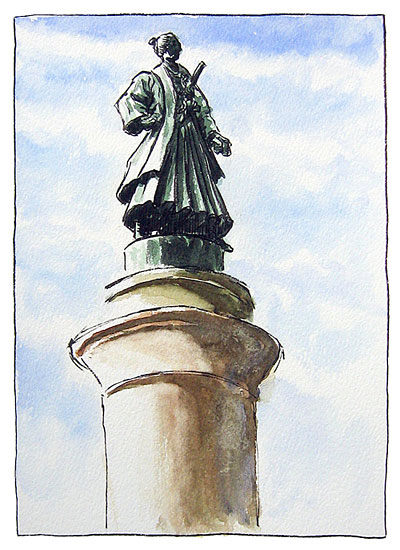 | ||
|
Page 9. Where, when and what to sketch (continued) Spectators Another challenge is spectators. You may be the type who loves to chat with strangers and won't find this a challenge at all. But it seems that most sketchers would rather work uninterrupted by passersby. One way to handle this is to always sketch in a group so that outsiders will be less likely to break in on your circle. Of course you can just accept the occasional interruption as part of the experience, be pleasant, and hope they go away. You yourself have probably come across somebody else sketching in the past, and can recall the positive thoughts entered your mind. Most people are not artists, and will have great respect for your art ability, and are merely curious.
If you sketch at popular tourist spots as I often do, you will meet a variety of people, all with cameras. I suspect there are a lot of photos out there of me sketching, although I'm usually not aware of it unless I hear the shutter click. If I'm lucky, the photographer will offer to e-mail me a copy. But even the most tolerant sketcher will meet his or her match sometime. One time I was sketching in a park and a middle aged woman stopped her bicycle right in front of me between me and my subject and proceeded to talk right in my face very loudly about people she knew who were artists, and then proceeded to talk about what ever entered her mind, apparently. There seems to be an abundance of this type of character in my town. After about twenty minutes of this, I finally packed up my things and walked away in search of another subject.
Sometimes a person will quietly creep up behind me and silently watch me work for a very long time, never saying a word from start to finish, even if I look at the person and say hello. Maybe it's a Tokyo thing. I find this very unnerving, and start to feel like a zoo animal. So I try to take this into consideration when deciding where to plant myself for a sketch. Standing with a wall at your back is very comforting, although it can get tiring, and may force you sketch small, and quickly. Family trips Family vacations hold the highest expectations for getting a lot of sketching done while in fact they are probably the worse settings to do any sketching at all. There's so much to see and do, and nobody in the group would dream of slowing down for fear of missing something that they will never have the chance to see again. You may get lucky when everybody takes an hour or so to go shopping, leaving you to sketch by yourself (but you yourself may be itching to go shopping, too!). Of course, if your family trip includes a day sitting around at the beach, then you are in sketcher's paradise! That's my kind of vacation. Public transportation If you use public transportation to go to go to work, then you can fill a small sketchbook with human subjects, most of them sleeping or reading. Sleeping people make great models. You could fill a sketchbook with just sleeping people. Of course you won't find much else to draw on a train or bus besides people. I've been doing this for many years and have a pile of subway sketchbooks now. The sketches need to be quick since you never know when your subject will get off the train, or somebody will get on and block your view. It's great practice. Of course, sketching in close quarters has its own challenges, and unless you have nerves of steel and don't mind the stranger next to you monitoring your every stroke, it is easier to sketch standing up with your back to a wall (I love walls) which means you have to stand in the end car or in front of a door since there is not much wall space on a commuter train. Also, if your sketchbook resembles a regular book or an organizer (Moleskines have this advantage) then people may not suspect you are sketching. Try not to bob your head up and down constantly as you look at the subject and back at your sketchbook, because you will draw attention to yourself. If your kids are sitting with you, watching you sketch, the sight of all those bobbing heads will surely sabotage your efforts to remain unnoticed. Also, when you are ready to return your gaze to the subject after drawing, look at something else rather than directly at the subject. If they realize you are sketching them, they will most likely shift their pose or even get up and move. Of course if you ride home at the same time and in the same train car every day, all the regulars will eventually catch on to the fact that you are sketching, and it will be a question of which one will be your next victim. I thought I had done a good job at hiding my activity until one day when I walked by a man on my way to my usual car, and he greeted me and said with a smile, "Hey, you're the guy who sketches, aren't you?" | ||||||||||||||
Next page >> |
 |
